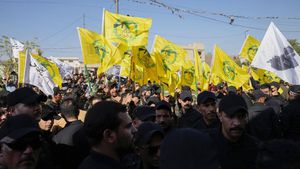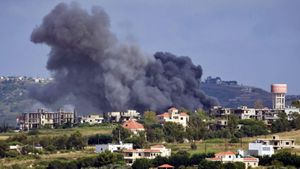On September 27, the Middle East echoed with the news of Hasan Nasrallah's death, the influential leader of the Lebanese militant group Hezbollah. At the age of 64, his passing has sparked both mourning among his supporters and relief among his adversaries. Known for transforming Hezbollah from its humble beginnings as a guerrilla movement to one of the most formidable paramilitary organizations, his legacy is as complicated as the region's politics itself.
The Israel Defense Forces announced today through a statement, "Nasrallah was eliminated" alongside other commanders during airstrikes aimed at Hezbollah's central operational hub located in southern Beirut. Following the intense air raids, which leveled several buildings and sent shocking plumes of smoke billowing over the neighborhood, Hezbollah confirmed their leader's death but withheld detailed information about the circumstances.
Under Nasrallah's leadership since the early 1990s, Hezbollah saw immense growth and evolution. Initially formed to combat Israeli occupation, the group morphed under his command, becoming not just a local force but also extending its operations to Syria, Iraq, and Yemen. His influence increased, especially during years of conflict, allowing him to position Hezbollah as not only Lebanon's dominant political party but also as a key player on the regional stage.
Reflecting on Nasrallah's impact, Daniel Ayalon, the former Israeli ambassador to the U.S., once remarked, "He is the shrewdest leader in the Arab world, and the most dangerous." This duality—revered by some and vilified by others—underscores just how significant his role was. His strategy often involved leveraging crises to boost Hezbollah’s standing, especially notable during the recent escalation in Gaza. Following Hamas's surprise attack last October, Hezbollah launched sporadic missile strikes against Israel, indicating its continued commitment to its adversarial stance.
The turmoil escalated recently when July airstrikes attributed to Israel killed Fuad Shukr, one of Nasrallah’s top commanders. The retaliatory measures saw Hezbollah unleashing dozens of rockets and drones at Israeli military sites—a demonstration of both capability and resolve, as Nasrallah himself articulated, emphasizing Hezbollah's ability to strike deep within Israeli territory. For close observers, this series of skirmishes felt like the beginning of a new chapter of violence.
Yet, it wasn’t just military accomplishments where Nasrallah left his mark. Despite not holding any formal government title, he emerged as Lebanon's de facto political leader. Under his guidance, Hezbollah secured seats within the Lebanese parliament and established ministries, effectively acting as the stronger authority versus the fragmented Lebanese state. His organization also built substantial infrastructural projects such as schools, clinics, and social services—filling gaps left by the Lebanese government.
Nasrallah’s commitment to Iranian leadership should also be noted. Actively supporting Shiite Iran's interests, he allowed Tehran to extend its influence across the Middle East. According to the U.S. Treasury Department, Nasrallah and his comrades were named as terrorists due to their roles propping up regimes like Bashar al-Assad’s Syria and orchestrated anti-American sentiments.
For Hezbollah's followers, Nasrallah was not simply a political figure; he was perceived as almost fatherly, providing moral guidance and representation for a community historically marginalized. He is credited with lifting Lebanon's Shiite population at large, often noted as the man who stood against Israeli aggression and galvanized resistance.
Visually, Nasrallah often utilized the black turban—symbolic of his lineage tracing back to the Prophet Muhammad—during his long-running televised addresses. Rarely seen publicly since 2014 due to numerous threats on his life, his communications played out through significant broadcasts, where he adeptly discussed topics ranging from personal issues to complicated geopolitical matters.
His death creates uncertainty, with experts like Hanin Ghaddar of the Washington Institute for Near East Policy stating, “Nasrallah is Hezbollah, and Hezbollah is Nasrallah.” With such intertwined destinies, his absence presents challenges not only for Hezbollah’s operational capabilities but also for Iran’s regional posture.
Tracing his path, Nasrallah was born on August 31, 1960, to modest beginnings, the son of a vegetable vendor. Initially captivated by religion, he went to study at the sacred Shiite city of Najaf, Iraq, where he joined the ranks of the Dawa party and began to shape his political ideology. Following the assassination of Hezbollah's founding leader Abbas al-Musawi, Nasrallah ascended to the helm, overseeing military strategies aimed at driving Israeli forces from Lebanese soil, culminating successfully in the withdrawal of Israeli troops from Lebanon in 2000. This military victory turned him from local leader to regional persona, celebrated as the only Arab leader to confront Israeli might directly.
Despite early victories, his rise did not come without contention. The Shiite extremism he symbolized began to incite resistance from other Lebanese communities. The divide sharpened after the assassination of Lebanon’s former Prime Minister Rafiq al-Hariri—a pivotal moment influenced by perceptions of Hezbollah's influence, followed by international investigations citing collective blaming of Syrian forces.
Even his resilience would be tested several years later during the 2006 summer war with Israel. Hezbollah, under Nasrallah’s guidance, mounted fierce resistance. Despite extensive Israeli military operations, Hezbollah retained sufficient strength to wage prolonged conflict, garnering admiration across Arab nations.
Yet, this power struggle within Lebanon also highlighted growing tensions as socioeconomic conditions deteriorated. The sectarian lines, evident during the Syrian Civil War, saw Hezbollah's interventions ignite intensified discord within the Lebanese populace. Nasrallah's decision to send troops to support Assad’s regime showcased sectarian priorities, alienated Sunni communities, and polarized Lebanon even more.
His shift from national hero to sectarian leader reflected broader changes within the region, particularly following the bankruptcy of the Lebanese economy around 2019, which severely strained Hezbollah’s financial ambitions, leading to the introduction of sanctions against Iran—Hezbollah's key ally. Such economic challenges began sowing discontent among those who once relied on his leadership for improvements.
Now, following his death, the major question remains: what will happen to Hezbollah? The organizational structure, heavily reliant on Nasrallah’s vision and charisma, is left to grapple with internal rivalries, strategic direction, and external pressures from Israel and the United States.
Experts believe the power vacuum left by Nasrallah could invite challenges from rival factions within Hezbollah and exacerbate internal divisions, potentially leading to destabilization. The delicate balance of power, alongside threats from Israel, urges vigilance as the region watches closely the evolution of Hezbollah and the legacy of its fallen leader.



